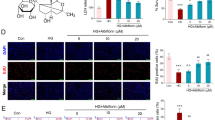Abstract
Objective
To study the effect of anticolchicine cytotoxicity of Dan Gua-Fang (丹瓜方), a Chinesea Chinese), a Chinese herbal compound prescription on endothelial cells of vein (ECV304) cultivated in mediums of different glucose concentrations as well as the proliferation of those cells in the same conditions, in order to reveal the value of Dan Gua-Fang in preventing and treating endothelial damage caused by hyperglycemia in diabetes mellitus.
Methods
The research was designed as three stages. The growing state and morphological changes were observed when ECV304 were cultivated in the culture mediums, which have different glucose concentrations with or without Dan Gua-Fang and at the same time with or without colchicine.
Results
(1) Dan Gua-Fang at all concentrations reduced the floating cell population of ECV304 cultivated in hyperglycemia mediums. (2) Dan Gua-Fang at all concentrations and hyperglycemia both had a function of promoting “pseudopod-like” structure formation in cultivated ECV304, but the function was not superimposed in mediums containing both hyperglycemia and Dan Gua-Fang. (3) Colchicine reduced and even vanished the “pseudopod-like” structure of the endotheliocyte apparently cultivated in mediums of hyperglycemia or with Dan Gua-Fang. The “pseudopod-like” structure of the endotheliocyte emerged quickly in Dan Gua-Fang groups after colchicine was removed, but it was not the case in hyperglycemia only without Dan Gua-Fang groups. (4) Dan Gua-Fang reduced the mortality of cells cultivated in mediums containing colchicine. The cell revived to its normal state fast after colchicine was removed.
Conclusion
Dan Gua-Fang has the functions of promoting the formation of cytoskeleton and fighting against colchicine cytotoxicity.
Similar content being viewed by others
References
Heng XP, Chen KJ. Diabetic intensive treatment and blood vascular complication. Chin J Integr Tradit West Med (Chin) 2008;28:563–566.
Heng XP, ed. Differential treatment of diabetic microvascular complications. 1st ed. Beijing: People’s Medical Publishing House; 2002:55–58.
Heng XP, Chen KJ, Hong ZF, He WD, Cu KD, Chen WL, et al. Glucose endothelial cytotoxicity and protection of Dan Gua-Fang, a Chinese herb prescription in HUVEC in hyperglycemia medium. J Diabetes Complicat 2009;23:297–303.
HAPO Study Cooperative Research Group, Metzger BE, Lowe LP, Dyer AR, Trimble ER, Chaovarindr U, Coustan DR, et al. Hyperglycemia and adverse pregnancy outcomes. N Engl J Med 2008;358:1991–2002.
Liu XP, Luo CY, Cao RX, Liu JH, Wen F, Li Y, et al. High glucose induced vascular endothelial growth factor expression via protein kinase C pathway in human umbilical vein endothelial cells in vitro. Chin J Arterioscler (Chin) 2006;14:17–20.
Duffy A, Liew A, O’sullivan J, Avalos G, Samali A, O’Brien T. Distinct effects of high-glucose conditions on endothelial cells of macrovascular and microvascular origins. Endothelium 2006;13:9–16.
Ezquer FE, Ezquer ME, Parrau DB, Carpio D, Yañez AJ, Conget PA. Systemic administration of multipotent mesenchymal stromal cells reverts hyperglycemia and prevents nephropathy in type 1 diabetic mice. Biol Blood Marrow Transplant 2008;4:631–640.
Luppi P, Cifarelli V, Tse H, Piganelli J, Trucco M, Luppi P, et al. Human C-peptide antagonises high glucose-induced endothelial dysfunction through the nuclear factor-kappaB pathway. Diabetologia 2008;51:1534–1543.
Huang WY, Sun H, Pan XQ, Fei L, Guo M, Bao HY, et al. Effects of colchicine on synthesis and excretion of cytokines and extracellular matrix by human renal fibroblasts. Chin J Pediatr (Chin) 2004;42:524–527.
Kovács P, Csaba G. Effect of drugs affecting microtubular assembly on microtubules, phospholipid synthesis and physiological indices (signalling, growth, motility and phagocytosis) in tetrahymena pyriformis. Cell Biochem Funct 2006;24:419–429.
Golestaneh N, Klein C, Valamanesh F, Suarez G, Agarwal MK, Mirshahi M. Mineralocorticoid receptor-mediated signaling regulates the ion gated sodium channel in vascular endothelial cells and requires an intact cytoskeleton. Biochem Biophys Res Commun 2001;280:1300–1306.
Heng XP. Strategies and methods for the treatment of diabetic neuropathy using integrative Chinese and Western medicine. Chin J Integr Med 2008;14:245–247.
Author information
Authors and Affiliations
Corresponding author
Additional information
Supported by the China Postdoctoral Science Foundation (No. 20070410128), CHEN Ke-ji Development Fund of Integrative Medicine (No. CKJ2006001) and Science Foundation of Health Department, Fujian Province (No. WZY0618)
Rights and permissions
About this article
Cite this article
Heng, Xp., Chen, Kj., Hong, Zf. et al. Anticolchicine cytotoxicity enhanced by Dan Gua-Fang (丹瓜方), a Chinese herb prescription in ECV304 in mediums. Chin. J. Integr. Med. 17, 126–133 (2011). https://doi.org/10.1007/s11655-011-0646-X
Received:
Published:
Issue Date:
DOI: https://doi.org/10.1007/s11655-011-0646-X




